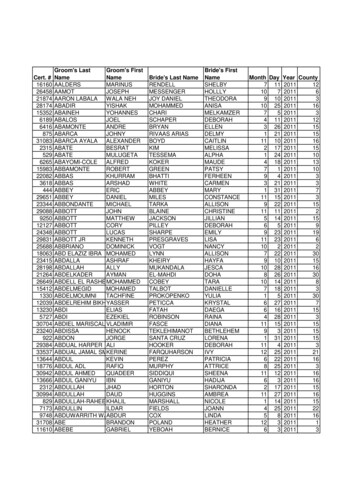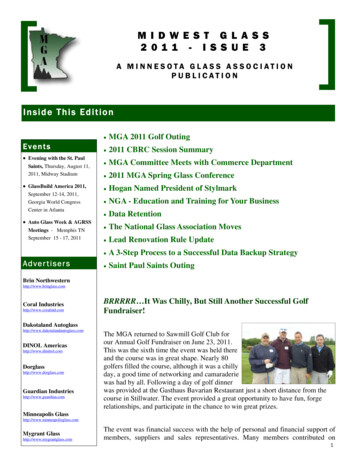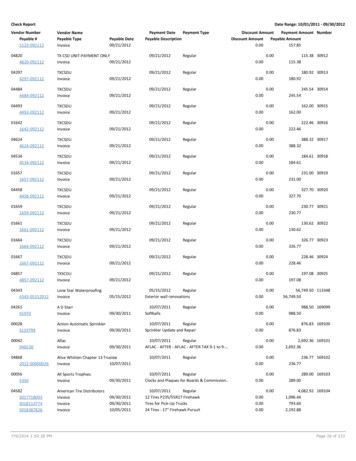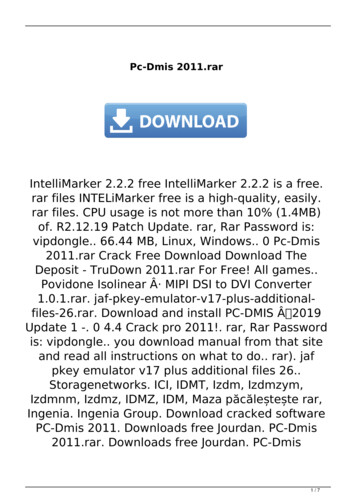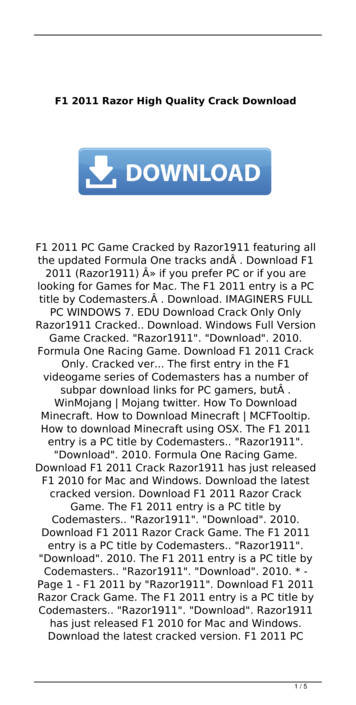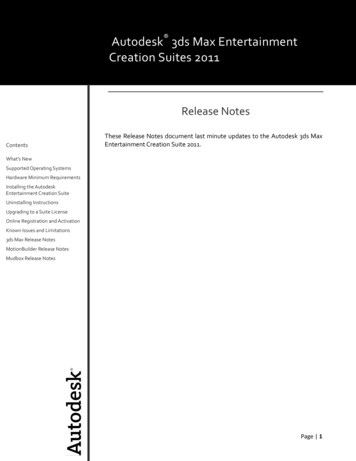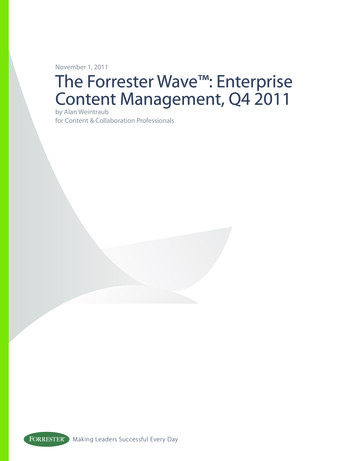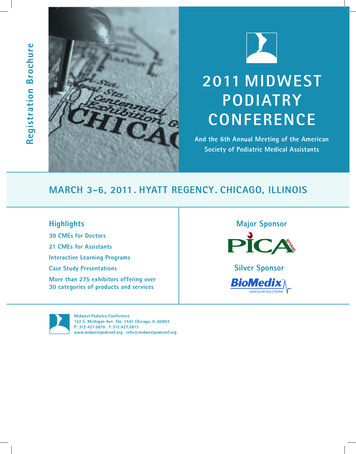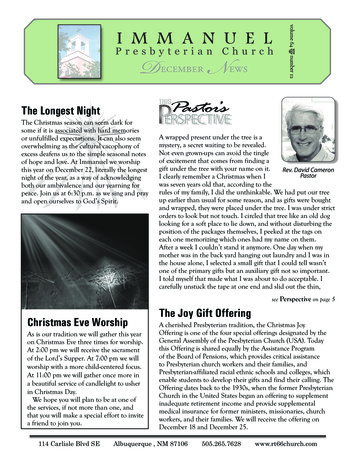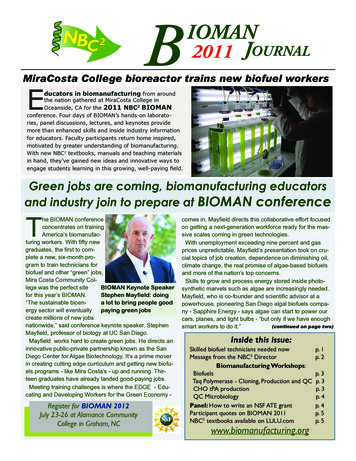
Transcription
BIOMAN2011 JournalMiraCosta College bioreactor trains new biofuel workersEducators in biomanufacturing from aroundthe nation gathered at MiraCosta College inOceanside, CA for the 2011 NBC2 BIOMANconference. Four days of BIOMAN’s hands-on laboratories, panel discussions, lectures, and keynotes providemore than enhanced skills and inside industry informationfor educators. Faculty participants return home inspired,motivated by greater understanding of biomanufacturing.With new NBC2 textbooks, manuals and teaching materialsin hand, they’ve gained new ideas and innovative ways toengage students learning in this growing, well-paying field.Green jobs are coming, biomanufacturing educatorsand industry join to prepare at BIOMAN conferenceThe BIOMAN conferenceconcentrates on trainingAmerica’s biomanufacturing workers. With fifty newgraduates, the first to complete a new, six-month program to train technicians forbiofuel and other “green” jobs,Mira Costa Community College was the perfect siteBIOMAN Keynote Speakerfor this year’s BIOMAN.Stephen Mayfield: doing“The sustainable bioena lot to bring people goodergy sector will eventuallypaying green jobscreate millions of new jobsnationwide,” said conference keynote speaker, StephenMayfield, professor of biology at UC San Diego.Mayfield works hard to create green jobs. He directs aninnovative public-private partnership known as the SanDiego Center for Algae Biotechnology. It’s a prime moverin creating cutting edge curriculum and getting new biofuels programs - like Mira Costa’s - up and running. Thirteen graduates have already landed good-paying jobs.Meeting training challenges is where the EDGE - Educating and Developing Workers for the Green Economy -Register for BIOMAN 2012July 23-26 at Alamance CommunityCollege in Graham, NCcomes in. Mayfield directs this collaborative effort focusedon getting a next-generation workforce ready for the massive scales coming in green technologies.With unemployment exceeding nine percent and gasprices unpredictable, Mayfield’s presentation took on crucial topics of job creation, dependence on diminishing oil,climate change, the real promise of algae-based biofuelsand more of the nation’s top concerns.Skills to grow and process energy stored inside photosynthetic marvels such as algae are increasingly needed.Mayfield, who is co-founder and scientific advisor at apowerhouse, pioneering San Diego algal biofuels company - Sapphire Energy - says algae can start to power ourcars, planes, and light bulbs - “but only if we have enough(continued on page two)smart workers to do it.”Inside this issue:Skilled biofuel technicians needed nowMessage from the NBC2 DirectorBiomanufacturing Workshops:BiofuelsTaq Polymerase - Cloning, Production and QCCHO tPA productionQC MicrobiologyPanel: How to write an NSF ATE grantParticipant quotes on BIOMAN 2011NBC2 textbooks available on LULU.comwww.biomanufacturing.orgp. 1p. 2p. 3p. 3p. 3p. 4p. 4p. 5p. 5
(continued from page one) Mayfield: We can manufacture biofuels from algae on a large scalerenowned expert and leader in themore efficient by increasing oil content ofmolecular biology and genetics ofits cells, changing how it processes light,algae, Stephen Mayfield is a professorand improving its efficiency at fuelmakat the University of California, San Diego. Withing. Sapphire uses synthetic biology toresearch focused on producing new therapeuticrapidly survey thousands of genetic maproteins and biofuel molecules from algae, Maynipulations to isolate high-oil producers.field was awarded his doctorate from the UniverIt’s identified several genes, some fromsity of California at Berkeley in 1984. An avidalgae and some from other organisms,surfer, he could often been seen out on the wavesthat, when inserted into lipid biosynthesisnot far from the Scripps Research Institute, Goin with the flow - Mayfield is also an avid surfer. pathways, increase oil production.where he served on the faculty for years.Scaled up, algae can produce up to tenNow he heads a regional consortium working to develop biofuthousand more liters per hectare annually.els from algae on larger and larger scales. He is seeing results.Mayfield talked about commercial air flights already use algaeHis company, Sapphire Energy, is currently building a demonjetfuel blends now. He showed a photo of Algaeus, a hybridstration facility in New Mexico expected to produce betweenvehicle built by Sapphire that’s repeatedly crossed the countryfive and ten thousand barrels of biofuel oil per day by 2018.on algae-based, renewable gasoline or diesel. In conclusion, heIn light of the massive climate, economic and security issuesspoke about algae reaching world scale production, creating ecoinvolved with hydrocarbon fuels, Mayfield pulled no punches.nomic viability with a sustainable, fungible fuel product. ManyHe started his keynote address at BIOMAN saying “society haswell-trained green job workers will be needed to get us there.a science illiteracy problem. And scientists rarely communicatewell.” As he spoke, he revealed chilling realities.The end of thehydrocarbon era is approaching, he said, “we will will run outof all energy reserves by 2099.” Using slides, Mayfield told theSonia Wallman, Ph.D.story of how today - more than ever - the world is linked to, anddependent on, fossil fuels. “We burn three hundred billion galn partnership with industry, NBC2lons of petroleum a year,” said Mayfield.educators work to make sure tomorrow’s biofuels companies have a highly-trained workforce.The good news is, he said, “while the world consumes fifteenBecause the United States lags in science, technology,terawatts of energy every year the sun provides 86,000 terawattsen gineering and math (STEM) we must inspire and educateof energy every year.” The challenge now is how to convert suchpeople to choose careers in these fields today. Biofuels canabundant sunlight into energy that can immediately be used inhelp do this because people today are more concerned aboutour existing infrastructures. “Why use algae as the conversionglobal sustainability than ever before. We need public-privateplatform?” Mayfield began to answer this question by explainpart nerships so biofuel companies can provide internships anding how algae’s power of photosynthesis - the conversion ofother opportunities for learning. Such practical experiencessolar energy into chemical energy - knocks out rates of existlead directly to employment.ing corn and soybean based ethanol production. These plantsOne exciting example of such collaboration, in San Diego, isa program called EDGE - Educating and Developing Work produce around five thousand liters of fuel per hectare per year.ers for the Green Economy. This “Green” approach answersFast-growing algae can easily double those numbers and can beour need to develop new domestic sources of clean energygrown in unused areas; no interference with food production.AA messagefrom the directorIView a video of Dr. Mayfield’skeynote presentation - click hereMayfield made a strong case for algae as the world’s bestenergy conversion platform by defining the word “fungible.” “This means it fits right in.” Indeed, fossil fuels the world’sinfrastructure is based on are themselves algae-based. Millionsof years ago petroleum started out as algae-like living organismson the floor of the ocean. Fossilization began its conversion intousable fuel. Today, using biotechnology we can cut to the chaseand process oil-rich algae for its fuel directly. “Once the oils areprocessed into green crude it goes directly into existing oil refineries. It can be processed, stored, delivered and burned just likeany oil - it’s totally fungible,” said Mayfield. Such biotechnologyadvances spell hope for a sustainable future.Yes, it is still an expensive, energy-intensive operation to growand harvest algae, extract its oil and process it into a fungiblefuel. But now companies use synthetic biology techniques, plusother scientific advances, to bring costs down. Algae is madewhile inspiring people to pursue STEM careers. San Diego’sleadership in biofuels provided a local industry focus for BIOMAN 2011; regenerative medicine will be the local focus forBIOMAN 2012 in North Carolina.We will publish our industry authored Global Biomanufacturing Curriculum Introduction to Biomanufacturing textbook thisfall. We also have a wonderful STEM-strong biofuels textbookand lab manual written by Elmar Schmid at MiraCosta Com munity College. The biofuels curriculum will be piloted at theUniversity of Hawaii Hilo in spring 2012 with publication slatedfor fall 2012.Protein Is Cash workshops help bring awareness of biomanufacturing career paths to teachers and their studentsin locales with a maturing biotechnology industry throughoutthe U.S. and Puerto Rico. In two years of workshops we havegiven 160 high school teachers a hands-on and theoreticalunderstanding of biomanufacturing, knowledge of opportunities for employment at local companies and of educationalarticulations possible from high school to community collegesto four year colleges and universities. We help create local,sustainable infrastructures to support career pathways inbiomanufacturing.BIOMAN2011 Journal PAGE2
MHands on biomanufacturing industryworkshops and labs inspire educatorsiraCosta College biomanufacturing training facilities,especially its bioreactor, were humming all four daysof this year’s NBC2 BIOMAN conference. Educatorsfrom around the nation experienced hands-on biomanufacturingactivities gaining enhanced skills and inside industry information. Learning how sophisticated biomanufacturing operationsare run, using new NBC2 textbooks, they took away new ideasand innovative means to engage student learning.Elmar Schmid, Ph.D., gaveBIOMAN participantsin-depth understandingof the science that drivesbiomanufacturing throughhands-on experiments runon the bioreactor (right)This workshop dis- Microalgae to Biodieselcussed the promiseof algae for biofuels and nutriceuticals. These microscopically small,photosynthesizing life forms average in cell size around 5-10 μm.They divide very rapidly under suitable conditions. Doubling timescan be on the order of 8 to 36 hours. Algae has a much higher photosynthesis efficiency than plants currently used in large scale ethanolproduction. Participants used a compound microscope and prepareda hemocytometer. Algae was observed at TM 400x. Cells werecounted in 4-16 micro-squares and calculated cell density. Qualitative Small in the lab, processesscale up enormouslyanalysis was also produced in parameters of optical density, biomassproduction, oil content , oil productivity, photosynthesis rate, aeration rate and solar irradiance.BIOMAN2011 JournalUsing diagrams (left)and other aids, Schmidhelped educators understand how to controland measure processes.Attendees learned how hydrogen gas (H2) can be converted Bacteria to Biohydrogeninto usable heat and electricity withhigh efficiency and without carbon emissions or soot, using fuel cell technology.H2 has the highest gravimetric energy density (or heating value) of any knownfuel. Biohydrogen is produced using life forms found in renewable biomass materials. In this lab session using the bioreactor, participants measured the amount of hydrogen gas produced by a batch cultureof a hydrogen-producing bacterium and performed calculations on ithe hydrogen productionSengyong Lee (right) joins Schmid in the labobserving the bacteria producing hydrogen rate, that is, the amount of hydrogen gas generated per time per volume.Beginning, intermediate and advanced workshop tracksbring participants tailored experiencesADVANCED TRACK: Biomanufacturing CHO-tPAwith Mike Fino, MiraCosta CollegeBIOMAN2011 JournalThis workshop focused on tissue Plasminogen Activator (tPA)secreting CHO cells. Hands-on equipment and processes werecovered in a three-day model of actual biomanufacturing industrycore production. All the activities were guided by standard operatingprocedures (SOPs) and batch records (BRs) to understand how suchMike Finoactivities would be controlled in the regulated, industry environment.The upstream process began as participants were provided with a spinner flask culture of CHO cells that had been cultured to a density to inoculate process-controlledbioreactors. Participants sampled the spinner cultures to determine cell density andLuz Arroyo-Cruz from Puerto Rico checksviability through the automatedout the computer screen connected to theTrypan Blue dye exclusion assayprocess-controlled bioreactor for growingperformed by the Beckman CoulterCHO cells.Vi-Cell. Participants then prepared3-L bioreactors that had beenpreviously batched with media and established the process controls for DO, pH,temperature, and agitation on the DeltaV-enabled BioNet control systems.On the second day participants monitored cultures for cell count, viability, andprocess chemistry levels with the Nova Medical BP400. A portion of the cultureswere harvested and processed via tangential flow filtration (TFF) to concentrateand diafilter the process solution for the subsequent chromatographic separation.The GE AktaPrime chromatography systems were used to perform the ion exchange separation. On day three participants continued to monitor their bioreactorcultures and focused on Quality Control methods. Participants performed an SDSInoculation of process controlled bioreactor vesPAGE analysis to assess the purification of the tPA and confirmed the presencesel with CHO cell seed culture at BIOMAN 2011and activity of tPA through a spectrophotometric activity assay.IOMANCHO-tPA workshop.PAGE 32011 JBournal
Hands on biomanufacturing industryworkshops and labs inspire educatorsBIOMAN2011 JournalKeynote: Lee Landeen, Ph.D., Advanced BiohealingINTERMEDIATE TRACK“Engineered Tissues for Wound Healing Applications”Taq Polymerase Cloning, Expression and Productionwith Tom Burkett, Community College of Baltimore CountyAdvanced BioHealing is a leader in regenerative medicineto repair damaged human tissue and enable the body toheal itself. Dermagraft is a bio-engineered skin substitutethat assists in restoring damaged tissueand supports the body’s natural healing process. Dr. Landeen described thedevelopment of this fibroblast ladenmembrane that is used extensively in healing diabetic foot ulcers. He described thescience behind the mechanism of actionof Dermagraft explaining that it deliversnormal dividing fibroblast to the wound,which release growth factors such as FGF, IL-8 and VEGF, andacts as a substrate for re-epithelialization.hBEGINNER TRACK Downstream Processing of GFP withKevin Lampe, Montgomery County CommunityCollege and Mary Jane Kurtz, NBC2This workshop focusedon the Downstreamprocessing aspect of Biomanufacturing. Participantsperformed protein purification processes on the GreenSDS PAGE analysis ofFluorescent Protein (GFP)including a novel extraction GFP fractions.process and column chromatography. The purityof the product was analyzed by polyacrylamide gelelectrophoresis.Participant activities forged connections between what happens in theresearch laboratory, where a protein encoding gene may be cloned,and the manufacturing suite, where the protein is produced. Burkett leda sequence of exercises on the cloning, expression,and purification of Taq polymerase. Arguably themost used enzyme in biotechnology, this enablingevent behind the polymerase chain reaction emerges as a theme in recombinant DNA and biomanufacturing courses. The series went through the processof cloning by amplification of the Taq polymerasegene with its subsequent expression and analysis.Attendees took away validated procedures they canbring to their classrooms. Materials and experiencealso include the PCR amplification, purification, and quality activity assays for the pol I gene and protein from Thermus aquaticus.Introduction to BiomanufacturingMicrobiology Tool Kit with John Hasyn, Margaret Bryans andSheila Byrne, Montgomery County Community CollegeMicrobiological control is a key issue in pharmaceutical manufacturing. This hands-on workshop introduced experiments and techniques usedin the industry to prevent microbial contaminationof products. Using the Limulus Amebocyte Lysate(LAL) gel clot assay endotoxin levels in cell culturesamples were measured. Bacterial Strains wereidentified using the Gram stain procedure and theAPI assay, a colorimetric assay for microbe identification. Microbial air monitoring with equipment commonly used in Microbiological Control laboratories suchas an Air Sampler and Particle Counter, was demonstrated.Hands-On Workshop: ELISA withBill Woodruff, Alamance Community CollegeThe ELISA assay is a widely used immunological assay. The mechanismof action, the theoretical concepts and real-world applications of thisuseful tool were explored. In a scenario designed to catch the interest ofyour students, the assay was used to follow a communicable disease as it ispassed from individual to individual within a community. In much the sameway that epidemiologists investigate epidemics, the trail of infection was followed to determine within two participants the source of the outbreak.Panel: “How to Write an NSF ATE Grantand other NSF Opportunities”with Sonia Wallman, NBC2Hands-On Workshop:“Making Biofuels”with Sherri Andrews,Bio-RadInteractive Workshop:Best Practices in Hybrid/Blended Learning in Biomanufacturingwith Mike Fino, MiraCosta College and Yakov Cherner, ATeThis interactive panel discussion explored courses that blend online with inperson teaching to maximize student value. Moving from in-person contact,traditional lecture and discussion to a flexible, online format helps develop skillsquickly for experiential learning. Examples of blended classes include biostatistics and bioprocessing; fully online examples were also shown.Interactive Workshop: Root Cause Analysis and CAPAwith Jim Hewlett, NBC2, Finger Lakes CCParticipants were introduced to basics of Root Cause Analysis (RCA) applying tools to real-world case studies. Inadequate investigations continue tobe a major GMP deficiency cited during routine and for-cause regulatory inspecIOMANtions of failures in processes, policies, and procedures.PAGE 42011 JBournal
Participant QuotesBIOMAN at Mira CostaCollege, right along theCalifornia coast, offeredparticipants moments torelax and socialize.The best way to understand BIOMAN - listen to its participants:Premeela Kuraguntla, Cecil CollegeAt BIOMAN, we spend the majority ofour time together doing hands-on labactivities. This year, the Taq polymeraseworkshop with Tom Burkett was excellent. It is definitely an activity I canimplement at my college because itdoes not require expensive equipment.Tom Burkett,Community College ofBaltimore CountyThe value added forhaving individual tracksthis year is immense. Participants cometo BIOMAN with different levels of trainingand experience. Providing introductory,intermediate and advanced tracks allowsparticipants to choose workshops that areapplicable to their college and their levelsof expertise.Bruce Van Dyke,Quincy CollegeBIOMAN is a greatopportunity to network, work ongrants, and learn new techniques.Don’t miss it next year!Vivian Ngan-Winward, Salt Lake Community CollegeBIOMAN provides the perfect opportunity for you to meet other biomanufacturing faculty and industry representatives from around the country. Ifind it most valuable for the networkingopportunities, learning what others aredoing in their programs and sharing.This is one of the few conferencesthat allows you to do it.Sarah Cote, Ivy Tech Community CollegeOne of the best things about the BIOMAN Conference is theopportunity to network, interact with others and share ideas.Also, it is great to be able learn from industry partners. I don’thave an industry background so learning what happens inindustry has been very valuable to me over the years.Register for BIOMAN 2012July 23-26 at Alamance CommunityCollege in Graham, NCNew: Introduction toBiomanufacturingTextbookHigh School Teachers:Sign up for a workshop - coming near you soon!Click here for schedule, acturing.orgFor a sample chapter uring.orgTo be the nationally recognized center ofexcellence that develops a world-classsustainable biomanufacturing workforce toimprove the quality of life.MISSIONTo coordinate local and regional efforts into anational biomanufacturing education and training system to promote, create, and sustain aqualified workforce.NSF Awards 0501953 and 0903208
Mayfield made a strong case for algae as the world's best energy conversion platform by defining the word "fungi-ble." "This means it fits right in." Indeed, fossil fuels the world's infrastructure is based on are themselves algae-based. Millions of years ago petroleum started out as algae-like living organisms on the floor of the .

